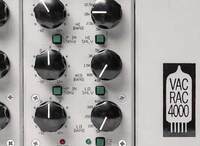
Review by George Shilling
Thermionic Culture’s enormous (and expensive) Fat Bustard summing unit includes a smooth-sounding EQ specially geared to mix buss usage. Perhaps inevitably, founder and designer Vic Keary received requests for a unit that include the EQ and Attitude sections, but not the summing. So, the newly released The Kite aims to satisfy those requests, and is about half the price of the Fat Bustard (£1,850 plus VAT). And although summing mixers have their fans, applying EQ to the mix buss is certainly a more dramatic change than any subtleties of the summing process in itself.
The Kite follows a similar house style to other Thermionic units, with a black finish like many of their existing products, for example The Rooster. Initially I was loaned a prototype of the standard version with “semi floating” inputs, and unbalanced outputs. However, this was later swapped for a transformer balanced prototype, which more happily matches with modern interfaces, with no loss of signal level. The production version of the latter will be finished with a purple front panel and is £2,250 plus VAT.

The rear panel is straightforward, including the high quality XLR connectors, IEC mains input socket (with integrated fuse holder) and mains voltage switch — much like most sister products from Thermionic.
The Kite’s operation is simplified by providing a single set of knobs which control both Left and Right channels simultaneously. The only exceptions to this are Output Gain knobs, and toggle switches for Bypass and -6dB output drop, all of which feature separate control for Left and Right. All rotating knobs are indented with 21 positions for easy recall.
Attitude
At the top left there is an Input Gain with a range of about -4.5 to +8dB. Below this are the aforementioned pair of Bypass toggles, handy for checking what you have done with the remaining controls. First up is Bass Boost, with accompanying toggle to select between 70Hz or 140Hz. In reality, these are only vague indications of what is occurring, as the bands are extremely wide bell curves, and according to the traces Vic provided they are centred lower than those frequencies. Whatever the case, this band provides a lovely warmth and weight. The range is simply indicated fro 0 to 10 (thank goodness; the Spinal Tap “goes to 11” gag has surely been done to death!) The whole range is usable, although full boost is unlikely to be needed often. Underneath this knob is a rotary switch for a High Pass filter, with settings of 0, 20 and 40Hz. This is a gentle slope and often works well in combination with the Bass Boost. Alongside is also a variable Bass Cut; this is a shelving EQ with corner frequencies selected with a toggle at either 400Hz or 1kHz. This is also a broad and gentle shaping band, and can be very effectively used in combination with the Bass Boost; I found that simultaneous boost and cut was terrific for removing mud I didn’t even realise was there! Above this is a knob for Top Shelf – no ‘adult’ magazines here, but instead a toggle switch to select a boost from either 700Hz or 1.2kHz upwards. Again though, these are gentle curves that have some effect even below those frequencies. Their broadness means a wonderful general brightening, adding clarity without doing anything nasty or brittle. The 700Hz setting tends to bring out vocal and electric guitar content, rather than just adding sheen. The last band is also a treble boost, a knob simply labelled Air and coloured white rather than the black of the other controls. This has a very high peak frequency of somewhere around 35kHz judging by the traces. It is quite powerful and will add sparkle to anything, and it’s interesting to juggle this with the Top Shelf band to effect different kinds of enhancement. Next is the red chicken head Attitude knob. This has six positions: 1 to 5 and Max. Like the similar control on the Rooster, this adds drive into the valves, making them start to crunch and at extreme settings slightly clamp down on the high end – roll-off is at about 9kHz on the Max setting.. To compensate from the extra gain, the output Trim knobs have a cut of up to about 11dB (and will boost +1.5dB), and additionally there are a pair of -6dB toggles to pad things down a bit. At lower settings it seems to mainly just add level, and tends to be more subtle than The Rooster which has more input gain; you need a strong input signal and some EQ boosting to drive The Kite into full-on distortion. But this more subtle approach is better suited to mix processing, and it’s perhaps more like driving a desk mix buss fairly hot.
The lovely thing about The Kite is that even when you don’t think your mix needs any additional processing, you find some extra magic by running it through this box and tweaking a bit. The relatively simple choices of frequency save much faffing about, and it always seems to improve and enhance whatever is running through it.
Pros: Beautiful sounding EQ for mix enhancement, combined controls for left and right channels, Attitude!
Cons: Standard unit is unbalanced.



